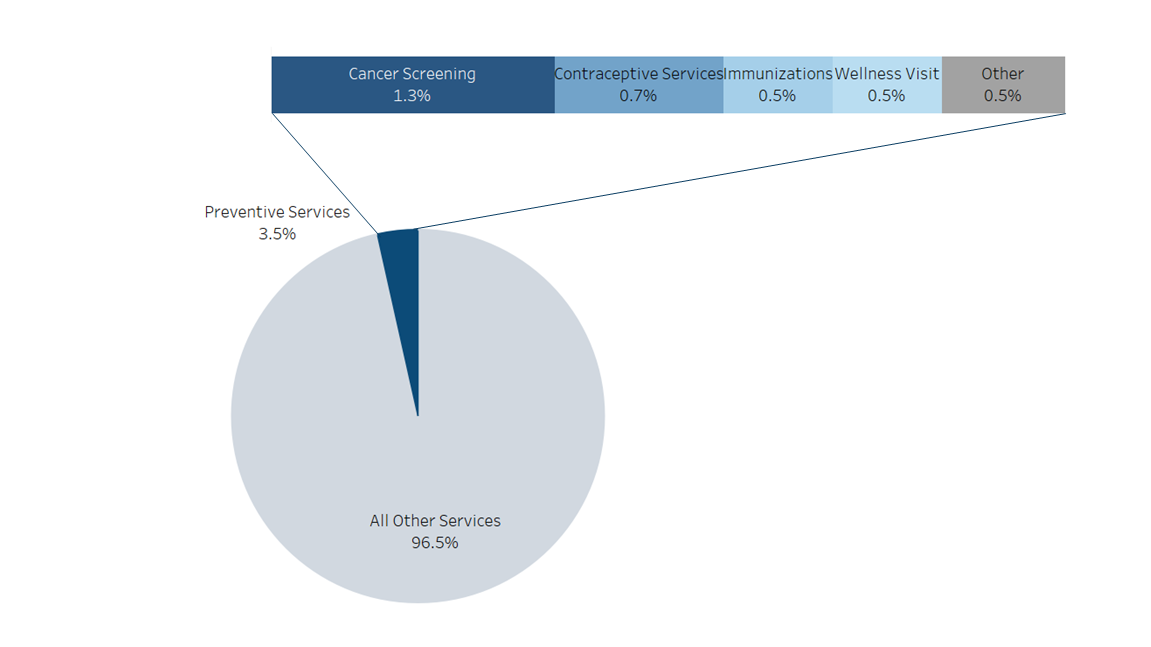The Affordable Care Act (ACA) requires insurers to cover certain services without charging patients out-of-pocket. These services include routine preventive care, such as wellness visits, immunizations, contraceptive services, and cancer and other disease screenings. In September 2022, a federal court ruled portions of the law’s preventive services provision unconstitutional. If the court decision stands, it is unclear whether private insurers will continue to cover preventive services at no cost to enrollees.
In this brief, we use HCCI data to better understand the costs that enrollees might face if the preventive services mandate were struck down entirely. We find that spending on preventive services represents a small fraction of total health care spending, but that the prices that individuals could face for preventive services are quite high if cost-sharing is allowed.
Among ESI Enrollees, Total Spending on Preventive Services was $204 per Person, or 3.5% of Total Health Spending
In 2019, total spending on preventive services was about $204 per person. This represents 3.5% of total dollars spent on health care services over the year.
Figure 1. Total spending on preventive services represents 3.5% of total health care spending in ESI

Of the no-cost preventive services, cancer screening made up the largest portion of total spending (1.3%), followed by contraceptive services (0.7%), immunizations (0.5%), and wellness visits (0.5%) (Figure 1). The remaining 0.5% was spent on all other preventive services combined. The graph below shows the $204 cost broken down by service category.
Figure 2. Total Dollars Spent Per Person by Service Category, 2019

Per person spending on preventive services is low, but costs to individuals could be prohibitively high
As shown above, when total spending on ACA covered preventive services is averaged across all ESI enrollees, per person spending on those services is just over $200 per person. If cost sharing for these services is reinstated, however, what individuals pay for these services could be much higher.
Table 1 shows the average price of a few common preventive services. The average price indicates what people would pay if each service were no longer covered by insurance or if they used the service before they reached their plan’s deductible. Table 1 illustrates that, although there are modest per person costs for preventive services when total spending is distributed across all enrollees, the prices that individuals face for these services could be much higher if they were no longer covered or subject to cost sharing. For example, the cost of a colonoscopy CPT code spread across the whole ESI population is $11 per person, but the average price of a colonoscopy for a person who receives the service is more than $1,400.
Table 1. Cost of Common Preventive Services
| Service | Total Spending across All Enrollees | Average Price (Amount individuals pay if service not coveredor before deductible is met) |
| Colonoscopy (CPT 45380) | $11 | $1,444 |
| Mammography (CPT 77067) | 24 | 255 |
| Insertion of IUD (CPT 58300) | 2 | 213 |
| Flu Vaccine (CPT 90686) | 2 | 21 |
| Cholesterol Test (CPT 80061) | 2 | 15 |
Even if the September 2022 court ruling stands, and portions of the ACA preventive services provision is overturned, insurers may continue offering preventive services without out-of-pocket costs to patients. It makes good business sense to cover preventive care rather than pay for more expensive downstream treatments. At the same time, there may be preventive services for which insurers will reinstate cost sharing, which could affect health care costs and individuals’ health outcomes. Studies show that even modest out-of-pocket costs can reduce the utilization of health care services. If individuals face out-of-pocket costs for preventive services, they may avoid routine health care, which could, in turn, have costly consequences.
Methods Note
The preventive services we used in our analysis were selected from a previous paper that looked at out-of-pocket costs for preventive care. Our analysis also included some covered prescription drugs, including contraceptives and PrEP, that were not included in the paper. We used the same methodology outlined in the paper to pull claims for preventive services. For prescription drugs, we pulled prescription drug claims that contained NDC codes for PrEP and prescription contraceptives.
ESI spending was calculated using the HCCUR methodology. Raw spending was calculated by summing the allowed amounts for each service category and CPT code. We weighted spending using ESI weights to develop estimates that were representative of the national ESI population younger than 65. ESI weights were calculated using the American Community Survey (ACS) 2020 5-year estimates Public Use Microdata Sample (PUMS). We excluded enrollees with evidence of non-ESI plan or claims where health plan was not the primary payer.
Average prices were calculated by dividing the total unweighted spending for each CPT code and dividing by the service count (count of distinct patient ID and service date combinations). Note that average price calculations at the CPT level only include costs for the individual CPT code, and not related ancillary services (e.g., labs, anesthesia, etc.).
Total spending figures were pulled from the 2022 Health Care Cost and Utilization Report (HCCUR).
The downloadable data contains service category per person spending and CPT level average prices and per person spending for 2019. Note that some price and spend data are not reported at the CPT level due to small cell counts.
